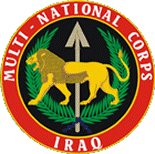Size 100,000 Founded 2004 | ||
 | ||
Active May 14, 2004 - December 31, 2009 Part of Multi-National Force – Iraq Similar Multi‑National Force – Iraq, XVIII Airborne Corps, III Corps, V Corps, United States Central C | ||
Multi-National Corps – Iraq (MNC-I) was a formerly multinational, later U.S. only, army corps created on 15 May 2004, fighting the Iraq War. Its superior body, the Multi-National Force-Iraq (MNF-I) had replaced Combined Joint Task Force 7 on May 15, 2004. The change was made due to "concerns that had existed for some period of time, that the Combined Joint Task Force 7 headquarters was not sufficient to handle the range of military operations in Iraq, including peace support, civil military operations, and at the same time conduct strategic engagement such as talking to the sheiks and talking to the political authorities."
Contents
Multi-National Force-Iraq was established to handle strategic level issues while Multi-National Corps – Iraq, a subordinate command, directed the tactical battle. A number of US Army corps headquarters have rotated into Iraq to provide the MNC-I headquarters. Also created under MNF-I was the Multi-National Security Transition Command - Iraq (MNSTC-I), which primarily directed the reconstruction of Iraqi security forces. With the planned drawdown of US forces from Iraq per the Status of Forces Agreement and President Barack Obama's announced timeline, Multi-National Corps – Iraq merged back into its parent command of MNF-I, which was renamed United States Force - Iraq (USF-I) following the withdrawal of all remaining coalition partners from the country.
In 2005, the 1st Corps Support Command based at Logistics Support Area Anaconda at Balad, Iraq, was providing theatre logistics support.
OIF-3
The two big units in OIF Rotation (OIF-3), announced by July 2004, were the 3rd Infantry Division, and the 42nd Infantry Division of the New York National Guard. The 3rd Infantry Division headquarters commanded two brigades of the division and the 256th Infantry Brigade of the Louisiana National Guard. The division relieved the 1st Cavalry Division in and around Baghdad.
The complete OIF-3 rotation to brigade level under MNF-I was as follows:
Headquarters XVIII Airborne Corps
OIF-4
The OIF 4 rotation was announced on 14 December 2004.
The 4th Infantry Division's second deployment to Iraq began in the fall of 2005. The division headquarters replaced the 3rd Infantry Division, which had been directing security operations as the headquarters for Multi-National Division - Baghdad. The 4th assumed responsibility on January 7, 2006 for four provinces in central and southern Iraq: Baghdad, Karbala, An-Najaf and Babil. On 7 January 2006, MND-Baghdad also assumed responsibility for training Iraqi security forces and conducting security operations in the four provinces.
The 36th Aviation Brigade's subordination is unclear. It is definitely deployed within MNF-I but whether it is actually under 4th Infantry Division/MND Baghdad is unknown.
The complete rotation to brigade level under MNF-I is as follows:
Headquarters: V Corps (Fwd)
OIF 06-08
The Pentagon announced on 20 June 2006 the units that will be deploying to Iraq as part of the OIF 06-08 rotation of forces:
OIF 07-09
OIF 09-11
Multi-National Corps-Iraq oversaw divisions in the north of Iraq (MND-N), in the west (Multi-National Force West, manned by units of the United States Marine Corps), in Baghdad (MND-B), and in the south (MND-S). MND-S was itself a fusion of two former multi-national divisions: Multi-National Division-Center (MND-C) and the British led Multi-National Division-Southeast (MND-SE). With the United Kingdom preparing to pull its remaining forces out of Iraq, the turnover of MND-SE marked the end of the last non-US led coalition force division remaining in Iraq.
